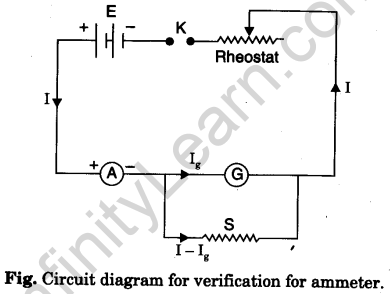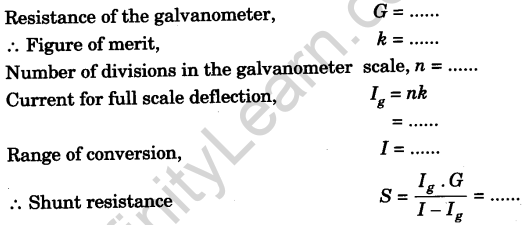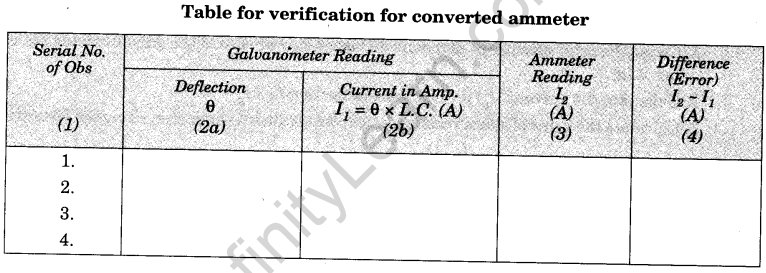Table of Contents
To Convert the Given Galvanometer (of Known Resistance and Figure of Merit) into an Ammeter of Desired Range and to Verify the same
Aim
To convert the given galvanometer (of known resistance and figure of merit) into an ammeter of desired range and to verify the same.
Apparatus
A weston type galvanometer, an ammeter of 0-3 A. range a battery of two cells or battery eliminator, two (10,000 Ω and 200 Ω) resistance boxes, two one-way keys, a rheostat, connecting wires, and a piece of sandpaper.
Theory

Circuit diagram

Procedure
- Count the total number of divisions on either side of zero of the galvanometer scale. Let it be n.
- Calculate the current (Ig) for full-scale deflection i.e., Ig = nk.
- Calculate the value of shunt resistance, for conversion into ammeter, using the formula,

where I is the range of conversion.
(The value of shunt resistance S is usually very small and a resistance box of that range is not available. Such small resistances are obtained by taking wires of copper, constantan, manganin, eureka, etc., of a suitable diameter and length). - Cut a length of the wire 2 cm more than the calculated value l. Mark two points on the wire, one cm away from each end. Connect this wire to the two terminals of the galvanometer such that the marked points are just outside the terminal screws. This galvanometer with shunt wire will now work as an ammeter of range I.
- Make the electric connections as shown in the circuit diagram.
- Insert the key and adjust the rheostat so that the galvanometer shows nearly maxi-mum deflection.
- Note the reading on the galvanometer scale and also the corresponding reading on the ammeter.
- Record your observations.
Calculations

Verification


Result
As the difference in the actual and measured value of currents (as recorded, in column 4) is very small, the conversion is perfect.
Precautions
Same as given in Experiment 8.
Viva Voce
Galvanometer
Question. 1. What is a galvanometer?
Answer. It is a device (instrument) used for detecting feeble electric currents in circuits.
Question. 2. What type of galvanometer is available in laboratories?
Answer. The laboratory galvanometer is a Weston Galvanometer. It has a pivoted coil.
Question. 3. Why the scale of the galvanometer has zero in the middle?
Answer. A needle at zero in the middle can deflect on both sides.
Question. 4. Do we have positive and negative terminals in a galvanometer?
Answer. No, a galvanometer has no positive and negative terminals. The pointer can deflect on either side from zero in the middle.
Question. 5. Why the divisions of a galvanometer scale are equally spaced?
Answer. Deflection in the pointer is proportional to the current passed. The number of divisions in deflection will be proportional to the current passed. I ∝= ∅.
Question. 6. Define the figure of merit of a galvanometer.
Answer. The quantity of current required to produce a deflection of one division in the galvanometer is called a figure of merit of the galvanometer. It is represented by the symbol k. Its unit is ampere per division.
Question. 7. Define the current sensitivity of a galvanometer.
Answer. The deflection produced in the galvanometer when a unit current is passed through it, is called the current sensitivity of the galvanometer.
Question. 8.How are ‘figure of merit’ and ‘current sensitivity’ related to each other?
Answer. They sire reciprocal, S1∝ 1/k
Question. 9. Why is the galvanometer called a moving coil galvanometer?
Answer.Because in this galvanometer, the coil moves (deflects), while the magnet remains fixed.
Question. 10. Is there any moving magnet galvanometer?
Answer. Yes, the tangent galvanometer is called a moving magnet galvanometer.
Question. 11. Why is a tangent galvanometer, called a moving magnet galvanometer?
Answer. Because in a tangent galvanometer, the magnet (a small pivoted magnetic needle) moves (deflects), while the coil remains fixed.
Resistance of a galvanometer
Question. 12. What do you mean by the resistance of a galvanometer?
Answer. The resistance of the coil of a galvanometer is called the resistance of the galvanometer. It is represented by the symbol G.
Question. 13. How do you determine the resistance of a galvanometer?
Answer. The resistance of a galvanometer is determined by the half-deflection method.
Question.14. Why is this method called the half deflection method?
Answer. It is so because the deflection is made half by using a shunt resistance S.
Question. 15. Under what conditions, G = S?
Answer. G = S, only when series resistance R is very high.
Ammeter
Question. 16. What is an ammeter?
Answer. An ammeter is a device (instrument) for measuring large electric currents in circuits.
Question. 17. How is an ammeter used in a circuit?
Answer. An ammeter is used in series in a circuit.
Question. 18. Why is an ammeter used in series in a circuit?
Answer. The whole current to be measured is passed through it.
Question. 19. What are the required properties of an ammeter?
Answer. An ammeter must have a very small resistance (zero, if possible) and a large current carrying capacity.
Question. 20. Why should an ammeter have a very small resistance?
Answer. So that when put in series in the circuit, it should not reduce much the original current to be measured.
Question. 21. Why should an ammeter have a large current carrying capacity?
Answer. So that it may measure large currents.
Voltmeter
Question. 22. What is a voltmeter?
Answer. A voltmeter is a device (instrument) for measuring the electric potential difference between two points in a circuit.
Question. 23. How is a voltmeter used in a circuit?
Answer. A voltmeter is used in parallel with that branch of the circuit at the ends of which the potential difference is to be measured.
Question. 24. Why is a voltmeter used in parallel in a circuit?
Answer. The potential difference to be measured is maintained at the terminals of the voltmeter.
Question. 25. What are the required properties of a voltmeter?
Answer. A voltmeter must have a very large resistance (infinite, if possible) and a very small current carrying capacity.
Question. 26. Why should a voltmeter have a very large resistance?
Answer.So that when put in parallel in a circuit, it should not divert much current from the parallel branch.
Question. 27. Why should a voltmeter have a very small current carrying capacity?
Answer.So that it may not withdraw much current from a parallel branch of the circuit.
Conversion of a galvanometer into an ammeter
Question. 28. Why is a galvanometer not suitable to work as an ammeter?
Answer. A galvanometer has more resistance and less current current-carrying capacity than those required by an ammeter. It will damage when a large current flow through it.
Question. 29. How is a galvanometer converted into an ammeter?
Answer. A galvanometer is converted into an ammeter by connecting a low resistance in parallel with the galvanometer coil (this parallel low resistance is called a shunt).
Question. 30. How does the low resistance in parallel (shunt) give the required properties to the galvanometer?
Answer. The shunt reduces the overall resistance of the ammeter (converted galvanometer) and increases its current-carrying capacity.
Question. 31. What is the order of resistance of an ammeter?
Answer. The ammeter resistance is nearly equal to the shunt resistance.
Question.32.What do you understand by the range of an ammeter?
Answer. It is the maximum value of the current that an ammeter can measure.
Question. 33. Which has lesser resistance—a 1-ampere range ammeter or a 10-ampere range ammeter?
Answer. Higher the range, lower the resistance. A 10 A ammeter has lesser resistance.
Question. 34. What is a milli-ammeter?
Answer. It is an ammeter that measures current in milliamperes (mA = 10-3 A).
Question. 35. What is a micro-ammeter?
Answer. It is an ammeter that measures current in microamperes (μA = 10-6 A).
Question. 36. What is the full name of an ammeter?
Answer. The full name of an ammeter is an ampere-meter.
Question. 37. Can we increase/decrease the range of an ammeter?
Answer. We can increase the range but cannot decrease the range of ammeter because for I < Ig, the value of shunt resistance becomes negative which cannot be possible.
Question. 38. What happens when an ammeter is placed in parallel with the circuit?
Answer. It cannot measure the current in the circuit because it only measures the current which is passing through it.
Conversion of a galvanometer into a voltmeter
Question. 39. Why is a galvanometer not suitable to work as a voltmeter?
Answer. A galvanometer has less resistance and more current-carrying capacity than those required by a voltmeter.
Question. 40. How is a galvanometer converted into a voltmeter?
Answer. A galvanometer is converted into a voltmeter by connecting a high resistance in series with the galvanometer coil.
Question. 41. How the high resistance in series gives required properties to the galvanometer?
Answer. The series high resistance increases the overall resistance of the voltmeter (converted galvanometer) and decreases its current-carrying capacity.
Question. 42. What is the order of resistance of a voltmeter?
Answer. The voltmeter resistance is of the order of series high resistance (R is in ten thousand, G is in hundreds).
Question. 43. What do you understand by the range of a voltmeter?
Answer. It is the maximum value of the potential difference which the voltmeter can measure.
Question. 44. Which has more resistance—a 1-volt range voltmeter or a 10-volt range voltmeter?
Answer. Higher the range, the higher the resistance. A 10 V voltmeter has higher resistance.
Question. 45. What is a milli-voltmeter?
Answer. It is a voltmeter that measures the potential difference in milli-volts (mV = 10-3 V).
Question. 46. What is a micro-voltmeter?
Answer. It is a voltmeter that measures the potential difference in micro-volts (μV = 10-3 V).
Question. 47. Does an ordinary voltmeter have infinite resistance?
Answer. No.
Question. 48. Name a voltmeter that has infinite resistance.
Answer. The electrostatic voltmeter has infinite resistance. It is also called an electrometer. An electronic voltmeter, called Vacuum Tube Volt Meter (VTVM), has nearly infinite resistance. It makes accurate measurements of potential differences. The potentiometer, at the null point, also acts as an ideal voltmeter (infinite resistance).
Question. 49. Can we increase/decrease the range of a voltmeter?
Answer. Yes. The range of the voltmeter can be increased by connecting a suitable high resistance in series and can be decreased by a suitable resistance in parallel.
Question. 50. What happens when a voltmeter is connected in series in a circuit?
Answer. The voltmeter cannot measure the actual p.d. in the circuit because of the overall resistance of the circuit increases.
Question. 51. What is a shunt? State its S.l. unit.
Answer. A small resistance connected in parallel with a galvanometer is called a shunt. Its S.l. unit is Olim.
Question. 52. Can a moving coil galvanometer be used to detect an a.c. in a circuit? Give reason.
Answer. It cannot be used to detect a.c. in a circuit since it measures the average value of current which is zero over a cycle.
Question. 53. Is the working of MCG affected by the earth’s magnetic field?
Answer. No. The earth’s magnetic field is very weak as compared to the strong radial magnetic field.
Question. 54. Which has more resistance (a) Ammeter or voltmeter (b) milliammeter or ammeter (c) milli voltmeter or voltmeter.
Answer. (a) voltmeter, (b) milliammeter, (c) voltmeter.
Question. 55. What do you mean by the resistance of a galvanometer?
Answer. The resistance offered by the coil of the galvanometer to the flow of current through it is known as resistance (G) of the galvanometer.




